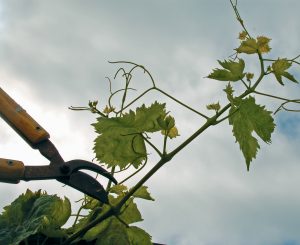Clip and Chip: An Alternative to Burning Agricultural Waste
Scenic vineyards offer relaxing outings in more rural parts of the Bay Area, while orchards supply farmers markets with fruit and offer families pick-your-own opportunities. Restaurants revel in the availability of local wines and produce for their tables. Sometimes, however, these amenities come with a helping of smoke — and not the kind from the barbecue grill — because the usual method for disposing prunings, old vines, and elderly trees is to scoop them into a pile and burn them, creating noxious billows that can blanket a valley or waft to neighboring areas.
Anyone who bemoans the demise of the fall bonfires after leaf-raking knows quite well that open burning is generally forbidden in the Bay Area, but there are exceptions. Among them are agricultural wastes from commercial vineyards and orchards, which may be burned during the year on designated “permissive burn days” when weather conditions promote adequate smoke dispersion and minimize potential ground-level air pollution impacts.
Not surprisingly, these agricultural waste fires create the same particulates that are a concern in fireplace smoke. Healdsburg winemaker and former environmental attorney Shelby Perkins has described the burning of vineyard prunings in the Napa Valley as a “net loss for the environment,” writing that the practice has damaged the health of residents and made wine production less sustainable.

The disposal of grapevine prunings and other agricultural waste is a significant environmental issue. (Photo by Alec MacDonald)
Air quality regulators are also concerned. “State law prevents us from banning ‘ag burning’,” observed Doug Tolar, senior air quality specialist for the Bay Area Air Quality Management District, “but it allows us to restrict it.” May 1 marked the start of the annual prohibition period for agricultural waste fires in the Bay Area, but by late fall, with prior Air District notification, woody refuse can again be piled high and torched.
Qualifying agricultural waste fires are only allowed after filing a notification form with details about the planned burn and paying a $100 notification fee. Starting in January 2015, however, Air District staff gave burn notification filers an alternative: chipping their agricultural waste, on the agency’s dime. Even without other efforts to publicize the new chipping program, “word is going around,” according to Tolar, “and almost 50 different growers have used it.”
In its first four months, the program has gone through about two-thirds of the $150,000 allocated by the Air District for 2015, with an average usage of about $2,000 to $3,000 in free chipping services per job. Burn notifications typically drop off during the annual prohibition period, so the remainder of the funding will be used less rapidly, but Tolar expects it to be fully spent. Chipping is more expensive than burning, particularly the preparation, so the free program eases the switch.
Tolar’s tracking shows that most of the program usage has been pruning-related, and as a result, he noted, “the majority [has] been in the North Bay, which has the most of that type of burning” (although Wente Vineyards in Livermore is one of the larger growers participating). When growers elect to chip their prunings, refuse piles need to be carefully prepared for the safety of chipping crews. For crop replacement, where trees or vines are completely removed, safety becomes even trickier, because “pile setup has materials that can be problematic — wires, roots with rocks, that kind of thing.” The Air District is looking into chipping equipment that can handle the more challenging materials as a possible way to expand the program.
Tolar’s hope is that the program “will serve as an example to those who are burning that there are alternatives, including mechanical ones such as chipping or shredding prunings.” In order to promote such alternatives, Napa Valley Grapegrowers, a wine industry coalition representing nearly 700 businesses across the county, has published a factsheet on vineyard prunings disposal that states, “Although there are valid reasons for considering burning grape prunings, the environmental benefits of the other primary methods of disposing of grape prunings should be given serious consideration.”
Ryan Decker, wine grower relations manager at Rodney Strong Vineyards, affirmed that on their estates, “as standard practice, all the annual prunings are returned in place to the vineyards, although, for vineyard replacement, older vines can have disease problems, so those are usually burned.” Decker was aware of the Air District program, although he was unsure if the winery’s vineyard management firm was using it, and his remarks confirm that, as Tolar hopes, “Some people are already doing it, willing to move toward alternatives to burning, already moving in this new direction.”
Leslie Stewart is the most recent former editor of the Bay Area Monitor.